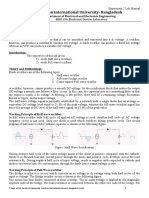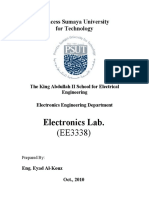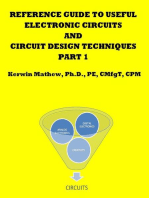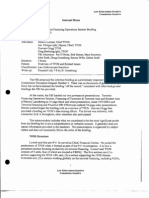Lab 8 Report Electronics 1
Lab 8 Report Electronics 1
Uploaded by
Dawn J. OwensCopyright:
Available Formats
Lab 8 Report Electronics 1
Lab 8 Report Electronics 1
Uploaded by
Dawn J. OwensOriginal Description:
Copyright
Available Formats
Share this document
Did you find this document useful?
Is this content inappropriate?
Copyright:
Available Formats
Lab 8 Report Electronics 1
Lab 8 Report Electronics 1
Uploaded by
Dawn J. OwensCopyright:
Available Formats
Electrical Engineering Program EEL 3117L Electrical Circuits Lab Fall 2013 Instructor: Dr.
. Kopp Lab #8: Diode Power-Rectifier Circuits Lab performed on November 4, 2013 Lab report due on November 18, 2013 Completed by: Dawn Owens (N00152181) Vanessa Guy (N0833323)
Abstract The objective of this lab was to understand how the DC power used in most electronic devices is actually AC power converted to DC power through the use of a step-down transformer, rectifier, filter, and a regulator. The step-down transformer decreases the AC line voltage to the value of DC voltage needed during application. Feeding the output of the transformer into a rectifier circuit alters the signal from a sinusoid to positive half cycles. To smooth out the output of the rectifier, a filter is used, which facilitates the generation of a constant DC voltage level. The lab required the conversion of an AC line voltage supplied by a transformer into a DC signal utilizing diode rectifier circuits. The conversion is investigated through the use of four different configurations of diode rectifier circuits, namely: a Half-wave rectifier, a Full-wave rectifier consisting of two diodes, a Full-wave bridge rectifier, and a Regulated Full-wave bridge rectifier. During pre-lab requisite values for the capacitors, which acted as filters to smooth the output, were calculated, and used during lab to construct the various configurations. Students became familiar with utilizing transformers to supply input voltage, AC to DC conversion, smoothing capacitors and voltage regulation. 1. Equipment Software Qty 1 Component NI MultiSim 12.0 Table 1. Software used to execute Lab 8. Value n/a
Hardware Qty 1 4 Component Dell Computer with Windows 7 Operating System Resistors Value 2.2k 5% 1.0k 5% - (2) 330 5% 1N4734A 1N4001 22 F 10 F - (3) 1 F .47 F 100 F
1 4 7
Zener Diode Diode Capacitor
8 pc. 1 pair 1 1 1 1 2
Breadboard Jumper Wire Wire Cutters Tektronix TDS 2014 4 Channel Digital Storage Oscilloscope Global Specialties Design and Prototyping PB-505 BNC to BNC AC plug ground isolation adapter BNC to Probe Table 2. Hardware used to execute Lab 8.
2. Procedure Using the requisite equipment listed in Table 2, the following exercises were executed: 2.1 Experiment 1: Half- Wave Rectifier Circuit The transformer located on the Global Specialties Design and Prototyping PB-505, a 1N4001 Diode, and a 2.2k resistor were connected as shown in the Figure 1 to construct a half-wave rectifier circuit.
Figure 1. Half-Wave Rectifier Circuit. The peak-to-peak voltage across the transformer secondary, and the peak voltage across the output are measured and recorded. The two values are then used to calculate the diode turn-on voltage.
3
Using Channel 1 and Channel 2 of the oscilloscope the transformer secondary voltage and output voltage images are captured. Subsequently, a filtering capacitor is inserted in parallel with the resistor, and the ripple voltage is measured. 2.2 Experiment 2: Full-Wave Rectifier Circuit The transformer located on the Global Specialties Design and Prototyping PB-505, two 1N4001 Diodes, and a 2.2k resistor were connected as shown in the Figure 2 to construct a full-wave rectifier circuit.
Figure 2. Experiment 2: Full-Wave Rectifier Circuit. The peak-to-peak voltage across the transformer secondary, and the peak voltage across the output are measured and recorded. The diode turn on voltage is calculated based on the two measured values. Using Channel 1 and Channel 2 of the oscilloscope the transformer secondary voltage and output voltage images are captured. Subsequently, a filtering capacitor is inserted in parallel with the resistor, and the ripple voltage is measured. 2.3 Experiment 3: Full- Wave Bridge Rectifier Circuit The transformer located on the Global Specialties Design and Prototyping PB-505 and four 1N4001 Diodes were connected as shown in the Figure 3 to construct a full-wave bridge rectifier circuit.
Figure 3. Experiment 3: Full-Wave Bridge Rectifier Circuit. Using the oscilloscope the peak voltage across the output is measured and recorded. A capacitor valued at 1F and a 2k load resistor are connected to the rectifier as shown in Figure 4.
Figure 4. Experiment 3: Full-Wave Bridge Rectifier Circuit with RC Filter/Load. The ripple voltage is measured for the following capacitor values: 1 F, 10 F, and 100 F. 2.4 Experiment 4: Regulated Full- Wave Bridge Rectifier Circuit The transformer located on the Global Specialties Design and Prototyping PB-505, four 1N4001 Diodes, a 100 F capacitor, a 1N4734A, a 270 resistor, and a 2k load resistor were connected as shown in the Figure 5 to construct a regulated full-wave bridge rectifier circuit.
Figure 5. Experiment 4: Regulated Full-Wave Bridge Rectifier Circuit. Measured and recorded the average voltage across the output. Subsequently, the 2k load resistor is replaced with a 330 resistor and the average voltage across the output is measured and recorded. 3. Results 3.1 Experiment 1: Half-Wave Rectifier Circuit Measurement Measured Value Resistor (2.2k) 2.166k Filter Components 32.47 F Peak to Peak Voltage across transformer secondary 36.2 Vp-p Peak Voltage across output 17.4 Vp Turn-on voltage of 1N4001 Diode 700 mV Table 3. Measured Values from Experiment 1: Half Wave Rectifier
Figure 6. Experiment 1: Transformer Secondary Voltage and Output Voltage. Pre-lab simulation resulted in Vripple of 3.216 V, and lab mea he turn-on voltage for a diode can be determined from a small signal I-V characteristic curve. The turn-on voltage is measured at the point on the graph where current flow is initiated on the Y-axis, because no current flows until a certain voltage is reached allowing the diode to conduct.
The measured turn on voltage for the 1N4001 Diode was determined from the graph to be 730 mV as shown in Figure 5, which is consistent with the approximated standard value of 0.7 Volts.
Figure 5. 1N4001 Diode I-V Characteristic Curve
The measured turn on voltage for the LED was determined to be 1.96V as shown in Figure 6, which is consistent with the simulated value determined during the pre-lab.
8
Figure 6. LED I-V Characteristic Curve 3.2 Experiment 2: LED Display Circuit Resistor values were determined by applying Constant Voltage Model Analysis to Figure 3. Given an input voltage of 5 Volts, and a 5 mA current through each LED, Equation 2 was used to calculate each resistor value as shown in Equation 3, 4, 5, and 6.
R1
(5 1.8V ) 640 0.005mA
(3)
R2
R3
(5 2.5V ) 500 0.005mA
(4.3 2.5V ) 360 0.005 mA
(4)
(5)
R4
(3.6 2.5V ) 220 0.005 mA
(6)
In lieu of actual resistors, 1k potientiometers were used and calibrated to the calculated resistor value. Successively increasing the input voltage at a frequency of 1kHz each LED illuminated, Table 3 depicts the turn on voltage necessary for each LED to emit light in the Simple Volume Display Circuit. Voltage Turn On (Peak to Voltage Peak Value) DS1 4.72 V 2.36 V DS2 4.72 V 2.36 V DS3 8.00 V 4.00 V DS4 8.00 V 4.00 V Table 3. Turn-on Voltages for LEDs in Simple Volume Display Circuit Lowering the frequency of the input voltage between the range of 1 Hz and 10 Hz, caused all of the LED lights to blink consistently. The latter end of the frequency range caused the pace of the blinking to increase. The audio input frequency range associated with music is approximately 20 Hz 20 kHz. Consequently, if LEDs were to blink at this frequency visibility would be impossible due to the rate of the blinking, and the ability of the human eye to monitor the point at which the LED reaches zero volts. 3.3 Experiment 3: Zener Diode I-V Characteristics using Oscilloscope X-Y Mode Zener Diode Turn-On Voltage Reverse Breakdown Voltage 0.7 Volts 5.40 Volts 1N4734A 0.7 Volts 8.20 Volts 1N4738A Table 4. Turn On and Reverse Breakdown Voltages for Zener Diodes Figures 7 and 8 shown below, depict the graphical representation of the I-V characteristics of the 1N4734A and 1N4738A Zener diode, respectively. LED
10
Figure 7. 1N4734A Zener Diode I-V Characteristic Curve
11
Figure 8. 1N4738A Zener Diode I-V Characteristic Curve 4. Questions
1. Explain the differences between a half-wave and full-wave rectifier. A half-wave rectifier generally utilizes one diode blocking half of the sinusoidal wave cycle, and allowing the other through resulting in output of either only the positive half-cycle or the negative half-cycle depending upon the direction of the diode. Whereas a full-wave rectifier utilizes both halves of the sinusoidal waveform by inverting one half and resulting in output of either two positive or two negative waveforms. 2. How does a full-wave bridge rectifier work? Be sure to discuss when current flows in each of the four diodes. A full wave bridge rectifier utilizes four diodes in a bridge topology, as shown in Figure 3,
12
which are labeled D1 to D4. The diodes are arranged in such a manner that only two diodes conduct current during each half cycle. During the positive half cycle of the supply diodes D2 and D3 conduct in series while D1 and D4 are reverse biased, therefore switched OFF, and the current flows through the load. During the negative half cycle of the supply D1 and D4 conduct in series, but diodes D2 and D3 are in reversed biased mode so now they are switched OFF. 3. What are the advantages of a full-wave bridge rectifier over a full-wave rectifier? The main advantage of a full-wave bridge rectifier over a full-wave rectifier is the elimination of the special center tapped transformer, which reduces the rectifiers size and cost. 4. What are the disadvantages of a full-wave bridge rectifier over a full-wave rectifier? To account for doubling number of diodes used in a full-wave bridge rectifier, the voltage must be reduced by double the VD,ON. While with the full-wave rectifier the voltage is reduced by VD,ON once. 5. What is the purpose of the 270 resistor in Figure 5? The 270 resistor acts in conjunction with the Zener diode that exhibits a small signal resistance in the range of 1 to 10 , which assist is providing a relatively constant output despite input variations. 6. Explain what the Zener diode doing in the circuit in Figure 5? The Zener diode regulates the output voltage by acting as a constant voltage drop in conjunction with the 270 , creating a voltage divider that attenuates the effect of Vin on Vout.
5. Conclusion This lab provided an introduction to diodes, and their respective current-voltage characteristics. This brief introduction created an environment to become familiar with ability to verify circuit measurements for circuits containing diodes, and circumventing machines containing established grounds to avoid short circuiting the circuit. References [ 1 ] B. Kopp, Lab 7 Diodes, Blackboard, September 2013. [2] B. Razavi, Fundamental of Microelectronics, Wiley, 2014.
13
You might also like
- Experiment No.1 Group 3Document25 pagesExperiment No.1 Group 3Janpherson BellecaNo ratings yet
- Civpro FlowchartDocument4 pagesCivpro FlowchartDawn J. Owens100% (7)
- Fanucbetadrive - PDF - POWER MOTION MANAGER FUNCTIONS PDFDocument200 pagesFanucbetadrive - PDF - POWER MOTION MANAGER FUNCTIONS PDFeletropaulomococa100% (1)
- ECE 301 Electronics 1: A. Half-Wave RectificationDocument24 pagesECE 301 Electronics 1: A. Half-Wave RectificationVince Hugo GutibNo ratings yet
- Report 1 Power eDocument12 pagesReport 1 Power eMuhd HafizzudinNo ratings yet
- Course - Section: - ECE20L-2 - E06 Group Number: Group MembersDocument11 pagesCourse - Section: - ECE20L-2 - E06 Group Number: Group MembersLuch ÜNo ratings yet
- EEE 4309C Lab 4 Common Emitter Amplifiers Lab ReportDocument15 pagesEEE 4309C Lab 4 Common Emitter Amplifiers Lab ReportDawn J. Owens100% (4)
- Comparative Law OutlineDocument25 pagesComparative Law OutlineDawn J. Owens100% (2)
- 117 Polynomial Problems From Amsp TocDocument3 pages117 Polynomial Problems From Amsp Toc26Thành NhânB100% (1)
- DEVICE EXP 2 Student - 2Document4 pagesDEVICE EXP 2 Student - 2Pablo ChanNo ratings yet
- Full Wave RectifierDocument6 pagesFull Wave RectifierXavier0% (1)
- Device Exp 2 Student ManualDocument4 pagesDevice Exp 2 Student Manualgg ezNo ratings yet
- ED Lab Experiment Manual 2Document6 pagesED Lab Experiment Manual 2mrcox17324No ratings yet
- Half Wave Rectifier and Full Wave RectifierDocument5 pagesHalf Wave Rectifier and Full Wave RectifierAdvyth Vaman AkalankamNo ratings yet
- Lab2 Report 1620660042Document21 pagesLab2 Report 1620660042Nafiz SheikhNo ratings yet
- Half Wave Rectifier and Full Wave RectifierDocument4 pagesHalf Wave Rectifier and Full Wave Rectifierjosephmathewt98No ratings yet
- Electronics Devices Lab - Exp 2 - Mid Term - Fall 22-23 - ACSDocument19 pagesElectronics Devices Lab - Exp 2 - Mid Term - Fall 22-23 - ACSdark lionNo ratings yet
- Lab 2 - Clampers N ClippersDocument5 pagesLab 2 - Clampers N ClippersDaus VillaNo ratings yet
- Asmat Ullah (70069423) Experiment:5: Circuit DiagramDocument11 pagesAsmat Ullah (70069423) Experiment:5: Circuit DiagramAsmat NiaziNo ratings yet
- Question of EE ProjectDocument5 pagesQuestion of EE ProjectANJALI KUMARINo ratings yet
- Experiment No. 1 - Creativity LabDocument5 pagesExperiment No. 1 - Creativity LabhloNo ratings yet
- TP3 Pwa32Document4 pagesTP3 Pwa32nelectsalgeriesetifNo ratings yet
- Electronics Circuit Design LabDocument34 pagesElectronics Circuit Design Labsrvdhar100% (1)
- 2011 Important PDFDocument6 pages2011 Important PDFShaheer DurraniNo ratings yet
- Lab 04Document10 pagesLab 0449 - 103 - Umair HossainNo ratings yet
- N. Bacalso Avenue, Cebu City: Cebu Institute of Technology - UniversityDocument15 pagesN. Bacalso Avenue, Cebu City: Cebu Institute of Technology - UniversityTreyes RobertNo ratings yet
- Experiment - 4 Half Wave Rectifier Pre - Lab QuestionsDocument8 pagesExperiment - 4 Half Wave Rectifier Pre - Lab Questionsgautam KrishnaNo ratings yet
- ECE334 Lab3Document5 pagesECE334 Lab3star89690% (1)
- PH 411 Physics Laboratory I (Electronics) : Instruction Manual IndexDocument28 pagesPH 411 Physics Laboratory I (Electronics) : Instruction Manual IndexReddyvari VenugopalNo ratings yet
- Electronics Device Circuit Lab SheetDocument27 pagesElectronics Device Circuit Lab Sheetjimfinch512No ratings yet
- Electronic Circuits and Devices Laboratory - ELCE-221 Experiment No. 2 Diode Applications (Part A) Rectifiers, ClippersDocument6 pagesElectronic Circuits and Devices Laboratory - ELCE-221 Experiment No. 2 Diode Applications (Part A) Rectifiers, ClippersLittle VoiceNo ratings yet
- Electronic Components Circuits: (Diode Characteristies - Rectifier - Clipper)Document14 pagesElectronic Components Circuits: (Diode Characteristies - Rectifier - Clipper)em2200139No ratings yet
- Clipping and Clamping Diode Circuits: Experiment 6Document6 pagesClipping and Clamping Diode Circuits: Experiment 6RastaSinghNo ratings yet
- 8 Surname, Given Name, Middle Name, Course Code & Title, Experiment No. and TitleDocument6 pages8 Surname, Given Name, Middle Name, Course Code & Title, Experiment No. and TitleKenneth SanguyoNo ratings yet
- Lab Manual Exp 8 - RectifierDocument7 pagesLab Manual Exp 8 - RectifierMohd Fazri SedanNo ratings yet
- EEE111 - Lab ManualDocument28 pagesEEE111 - Lab ManualAnindita MishiNo ratings yet
- Ecgr3155-Experiment 4-Diodes and Bridge RectifiersDocument8 pagesEcgr3155-Experiment 4-Diodes and Bridge RectifiersPhạm Đào Hoàng LongNo ratings yet
- Lab Report 2Document17 pagesLab Report 2EvaNo ratings yet
- EPD Lab#9Document8 pagesEPD Lab#9Muhammad ShaheerNo ratings yet
- Electronic Devices and Circuits (EME-306) Lab 1: ObjectiveDocument7 pagesElectronic Devices and Circuits (EME-306) Lab 1: ObjectiveAhmed SayedNo ratings yet
- Lab3 PowersupplyfinalDocument10 pagesLab3 PowersupplyfinalShiela Mae ReyesNo ratings yet
- Chapter 1c (RECTIFIER)Document15 pagesChapter 1c (RECTIFIER)Akmal Amyrul Aizat100% (1)
- Eee DepartmentDocument11 pagesEee DepartmentAriston EtormaNo ratings yet
- 01 - Experiment Diode j09Document19 pages01 - Experiment Diode j09Ahmed Sobhy KhattabNo ratings yet
- Lab Manual 3 Semester Basic Electronics - I: Lab Engineerer: Subject TeacherDocument21 pagesLab Manual 3 Semester Basic Electronics - I: Lab Engineerer: Subject TeacherOmer Sheikh100% (1)
- Laboratory Manual For Linear ElectronicsDocument102 pagesLaboratory Manual For Linear Electronicssamactrang100% (1)
- Yasin Half Wave Full WaveDocument10 pagesYasin Half Wave Full Wavemd yasin hasanNo ratings yet
- Laboratory Experiment 4 Rectifiers and FiltersDocument16 pagesLaboratory Experiment 4 Rectifiers and FiltersPajayNo ratings yet
- Experiment 2 Wave Shaping CircuitsDocument9 pagesExperiment 2 Wave Shaping CircuitsMaria Abia Lapena50% (2)
- Indian Institute of Technology Ropar Electrical Engineering DepartmentDocument3 pagesIndian Institute of Technology Ropar Electrical Engineering Departmentrahul.23eez0004No ratings yet
- Lab 1 Power SupplyDocument7 pagesLab 1 Power SupplyKatherine YenNo ratings yet
- Lab 1 Single Phase Diode RectifiersDocument14 pagesLab 1 Single Phase Diode RectifiersM Hassan BashirNo ratings yet
- ElectronicsLab - Manual March2010Document64 pagesElectronicsLab - Manual March2010pnarendrareddy.mscNo ratings yet
- Lab Report 2Document11 pagesLab Report 2Mike TNo ratings yet
- ECE20L - 2 - Expt4Document10 pagesECE20L - 2 - Expt4Niko de LemosNo ratings yet
- ECCE4466: Power Electronics Student Lab Manual: Department of Electrical and Computer EngineeringDocument20 pagesECCE4466: Power Electronics Student Lab Manual: Department of Electrical and Computer Engineeringsenpai_mendozaNo ratings yet
- Electronic Unit 1Document35 pagesElectronic Unit 1Sudheer ManepalliNo ratings yet
- 6 Surname, Given Name, Middle Name, Course Code & Title, Experiment No. and TitleDocument5 pages6 Surname, Given Name, Middle Name, Course Code & Title, Experiment No. and TitleKenneth SanguyoNo ratings yet
- (ALCANTARA - BSEE-2D) Experiment 2 Final ReportDocument11 pages(ALCANTARA - BSEE-2D) Experiment 2 Final ReportLawrence Abram AlcantaraNo ratings yet
- Power Electronics ManualDocument42 pagesPower Electronics ManualJavaria Chiragh50% (2)
- Lab Report 03Document8 pagesLab Report 03fkhan201160No ratings yet
- REEEFFFSESDocument6 pagesREEEFFFSESezradural99No ratings yet
- Reference Guide To Useful Electronic Circuits And Circuit Design Techniques - Part 1From EverandReference Guide To Useful Electronic Circuits And Circuit Design Techniques - Part 1Rating: 2.5 out of 5 stars2.5/5 (3)
- Reference Guide To Useful Electronic Circuits And Circuit Design Techniques - Part 2From EverandReference Guide To Useful Electronic Circuits And Circuit Design Techniques - Part 2No ratings yet
- Thermodynamics ProjectDocument1 pageThermodynamics ProjectDawn J. OwensNo ratings yet
- CE6850-HI-F-B00 - DatasheetDocument7 pagesCE6850-HI-F-B00 - DatasheetJosimar MoreiraNo ratings yet
- Google LLC Is AnDocument3 pagesGoogle LLC Is AntestNo ratings yet
- Bank Clients Perception of Information Technology Usage, Service Delivery and Customer Satisfaction Reflections On Uganda's Banking Sector - FaythDocument33 pagesBank Clients Perception of Information Technology Usage, Service Delivery and Customer Satisfaction Reflections On Uganda's Banking Sector - FaythShafiqud DoulahNo ratings yet
- Aplikasi Decision Support System DSS Dengan Metode PDFDocument15 pagesAplikasi Decision Support System DSS Dengan Metode PDFAhmad FataNo ratings yet
- Dumpsys ANR WindowManagerDocument3,626 pagesDumpsys ANR WindowManagerArmando SamoilaNo ratings yet
- Print - ContentsDocument5 pagesPrint - ContentsPhan Văn TúNo ratings yet
- Question Bank Adv Java-2024Document3 pagesQuestion Bank Adv Java-2024nirajkumarsingh3246No ratings yet
- Food Monitoring System Using IotDocument4 pagesFood Monitoring System Using IotInternational Journal of Innovative Science and Research TechnologyNo ratings yet
- Quantus Fluorometer Operating Manual TM396Document17 pagesQuantus Fluorometer Operating Manual TM396vengat veeraNo ratings yet
- HR Interview Questions For Developer With SampleDocument6 pagesHR Interview Questions For Developer With Sampleramnothing1111No ratings yet
- Hypothesis Testing SeminarDocument10 pagesHypothesis Testing SeminarJacky C.Y. HoNo ratings yet
- Braindumps: Prep Your Actual Exam Test With Our Valid Braindumps For Successful PassDocument4 pagesBraindumps: Prep Your Actual Exam Test With Our Valid Braindumps For Successful PassramanaraoNo ratings yet
- The Hard Part of Learning A Language: Are There Official Docs?Document1 pageThe Hard Part of Learning A Language: Are There Official Docs?Esther Vilar MasculinismeNo ratings yet
- SWICOM AlfredDocument25 pagesSWICOM AlfredAlfred Manoj KumminiyilNo ratings yet
- T4 B16 Team 4 Interviews FDR - Internal Memo - FBI TFOS - Terrorist Financing Operations Section 290Document8 pagesT4 B16 Team 4 Interviews FDR - Internal Memo - FBI TFOS - Terrorist Financing Operations Section 2909/11 Document ArchiveNo ratings yet
- Branch DetailsDocument15 pagesBranch Detailsgamersingh098123No ratings yet
- BGP Attributes and Policy2Document43 pagesBGP Attributes and Policy2Akhmed Abdul BabaNo ratings yet
- Assessment Task 3 - BSBLDR511Document13 pagesAssessment Task 3 - BSBLDR511Maja ChagorskyNo ratings yet
- The Network of NetworksDocument15 pagesThe Network of NetworksHelenNo ratings yet
- 4front TruePianos PDFDocument24 pages4front TruePianos PDFAnupamSinghNo ratings yet
- CheatSheet FortiOS 6.0 PDFDocument2 pagesCheatSheet FortiOS 6.0 PDFJDNo ratings yet
- TC-700P Service Manual R1.0 PDFDocument100 pagesTC-700P Service Manual R1.0 PDFAyman ZaterNo ratings yet
- Formato - Reading ComprehensionDocument3 pagesFormato - Reading ComprehensionlkiNo ratings yet
- Week2a BasicElementsinC#Document9 pagesWeek2a BasicElementsinC#EdrianCliffDelPilar100% (1)
- The Dove Vol. XI June 12, 2019Document14 pagesThe Dove Vol. XI June 12, 2019Ric SalvadorNo ratings yet
- Gen Pact ResumeDocument2 pagesGen Pact ResumeroyalbhanusriNo ratings yet
- BasisDocument8 pagesBasisUntung Teguh BudiantoNo ratings yet
- Online Railway Reservation System Documentation PDFDocument25 pagesOnline Railway Reservation System Documentation PDFIshmael MakhembuNo ratings yet





























































































